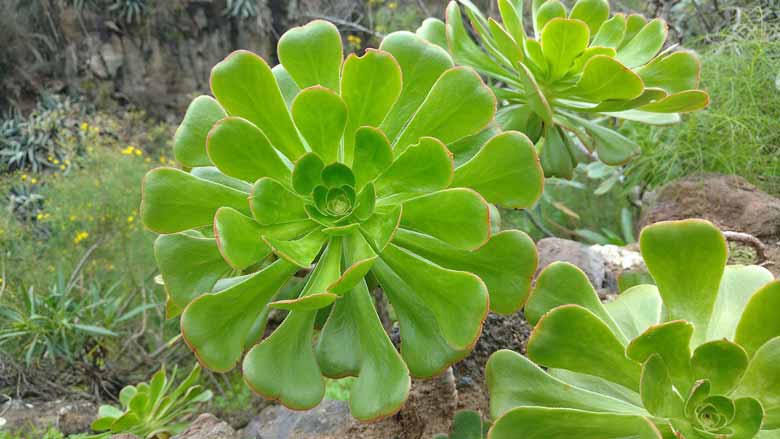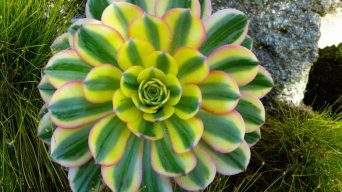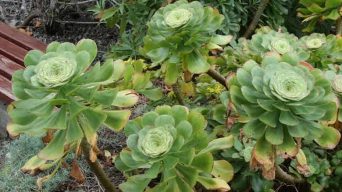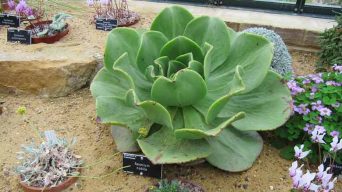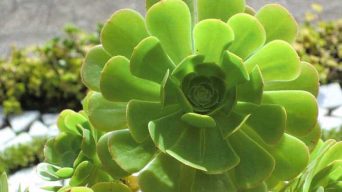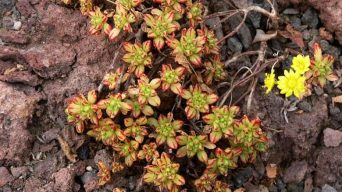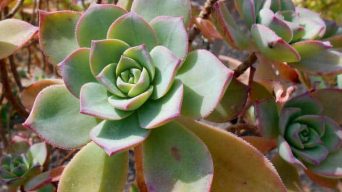The Aeonium canariense ‘Giant Velvet Rose’ is a beautiful succulent plant that grows well in various environments.
It is a versatile plant, and its variegated foliage contrasts nicely with any garden.
It’s an excellent choice for those who want to add a little greenery to their home or office.
Aeonium canariense care is a relatively straightforward process.
This article will give you everything you need to know about taking care of and propagating the Aeonium canariense succulent plant!
Overview
| Family: | Crassulaceae |
| Genus: | Aeonium |
| Botanical Name: | Aeonium canariense |
| Synonyms: | Sempervivum canariense |
| Common Names: | Giant Velvet Rose, Canary aeonium |
| Origin: | Island of Tenerife in the Canary Islands |
| USDA Hardiness Zones: | 9 – 11 |
| Size: | 1 foot (30 cm) tall and rosettes up to 8 inches (20cm) in diameter |
| Sun Exposure: | Full sun to partial shade |
| Water Needs: | Water thoroughly but infrequently |
| Soil Type: | Well-draining soil |
| Temperature: | 64°-75° degrees Fahrenheit (18°-24° celsius) |
| Humidity Levels: | 40-80% |
Aeonium canariense, commonly known as the Giant Velvet Rose, is a distinctive flowering plant in the family Crassulaceae and the genus Aeonium.
It is endemic to Tenerife in the Canary Islands, which is why it is also known as the Canary Island Aeonium.
The Aeonium canariense succulent plant bears large rosettes of green leaves that turn reddish when grown in full sun.
This Aeonium species can grow up to 1 foot (30 cm) tall and has rosettes up to 8 inches in diameter.
Aeonium canariense’s flowering stems bloom in summer, reaching up to 3 feet (90 cm) with star-shaped, yellow flowers that are a quarter of an inch (0.64 cm) wide.
The Giant Velvet Rose succulent plant is a monocarpic perennial, meaning it only blooms once before dying off entirely after flowering.
How To Care for Aeonium Canariense ‘Giant Velvet Rose’
The Giant Velvet Rose care is a simple process.
Below you will find all the information you need to know about taking care of the Aeonium canariense.
Sun Exposure & Light Requirements
Aeonium canariense is a plant that requires partial shade.
It can handle a bit of sun but needs to be shaded during the hottest hours.
In a fully sunny location where nothing else is growing, this Aeonium plant will not grow or thrive well. It could become burnt in the summer heat.
This plant prefers a location with a lot of shade and some direct sunlight.
Aeonium canariense does not do well in low light, so it needs a bright spot, but not a place that is shaded all day.
The best location for an Aeonium canariense succulent would be a north-facing window or a south-facing porch with partial shade in the midday and some direct sunlight for a few hours daily.
Watering Requirements
Aeonium canariense succulents should be watered only when the soil is dry. They are drought-tolerant plants.
They will need a lot of drainage and water when they first arrive, but you mustn’t overwater them once they have settled in their new home.
You should water them only if the soil becomes dry to the touch at least three inches down.
You can test this by using your finger or a screwdriver to estimate the moisture left in the soil.
If the soil is moist, it isn’t necessary to water again until a week or two has passed and the grounds are dry.
When succulents receive excessive water, they may develop brown leaf tips and suffer from root rot.
Soil Requirements
The Aeonium canariense prefers a well-draining soil mixture with a lot of sand or perlite.
The potting mix should combine a well-draining succulent soil, sand, and perlite.
The Aeonium canariense needs a potting medium that is porous enough for water drainage but retains moisture well.
It will rot if it stays wet too long, so avoid overwatering this Aeonium variety.
Temperature and Humidity
Aeonium canariense thrives in a temperature range of 64°-75° degrees Fahrenheit (18°-24° Celsius).
During a typical day, You should provide these plants a temperature range of 65°-70° degrees Fahrenheit (18.33°-21.11 ° Celsius).
Aeonium canariense is tolerant to a broad spectrum of humidity levels ranging from 40%-80%. The average humidity level for this plant would be 60%.
Humidity needs may vary depending on the environment that it lives in.
It also has a high drought tolerance, meaning there is no need to water every week, and they will still grow nicely!
Fertilizing
Aeonium canariense doesn’t require a lot of fertilizing.
You will need to fertilize this plant at least once a month during the growing season but a little more as the plant matures.
Fertilize with a water-soluble, time-release fertilizer or granular slow-release fertilizers during the growing season.
You can also use half-strength diluted liquid fertilizer.
There’s a common misconception that Aeonium succulents need high fertilizer levels to grow well.
This is not the case, so don’t over-fertilize your Aeonium canariense!
Potting and Repotting
When a succulent starts to outgrow its container, it’s time for a repot. The Aeonium canariense plant is no exception.
Make sure to purchase a pot at least two inches larger than the previous one. Fill it with a succulent-friendly soil mix, such as peat moss, sand or perlite, and vermiculite.
The process for an Aeonium canariense repot starts by loosening the root ball so you have enough room to work around them without damaging any roots in the process.
Carefully remove the Aeonium canariense from the pot and gently tease the roots apart with a root hook or your fingers.
If the plant is pot-bound, you may need to cut away a portion of its root ball to fit comfortably into a larger container.
Plant the Aeonium canariense succulent back into a new pot and thoroughly water before adding any extra soil amendments (if needed).
You will want to water a newly repotted plant a few more times over a week or two so it has time to reestablish its roots in a new container.
Pruning
Pruning Aeonium canariense is a touchy subject. Some people say never to prune them. Some others say that they should be done twice a year.
The truth is that Aeoniums are self-pruning and will do it themselves if you just let them grow naturally without the gardener’s intervention.
You should only consider pruning a necessary measure if Aeoniums become unhealthy and the roots are about to be smothered by a pile of dead leaves.
The best time for pruning is in late spring or early autumn before frost has set in.
The new leaves are a vital energy store for the plant, so pruning them prematurely can lead to a long-dormant period.
To avoid this problem, cut off only a few branches at a time and wait until spring before doing more cutting back.
When pruning Aeonium plants, always use sharp clippers or scissors because these succulents have very brittle tissue inside their stems.
Pests and Diseases
Aeonium canariense succulents are prone to a few pests and diseases.
- Aphids are green, aphid-like insects that feed on the juices of plants. You can control them by knocking them off your plant and using a soap spray to keep them away.
- Spider mites look like a spider and spin silky webs close to their prey to capture it easier. Control with a strong stream from a garden hose or use pesticides specially made for this problem.
- Scale bugs are a type of insect that sucks sap from leaves and stems. A regular spray can control them with a strong stream from a garden hose to knock them off the plant.
- Powdery mildew is more common on hot days when humidity levels are high but can show up at other times. Spray infested areas with water and then dust those same areas lightly with baking soda (to kill fungus).
- Pythium is a fungus that shows up as black patches on the soil surface or dark brown patches near the base of plants, usually during wet weather periods in the summertime. It’s essential to water less frequently when it appears because too much water will make this problem worse.
- Botrytis is a fungus that grows on stems and leaves at low night temperatures. Control with a strong stream from a garden hose to knock down the spores, and spray or dust those areas with baking soda (to kill off fungi).
How To Prevent Pests and Diseases
Providing a healthy, clean environment is the best way to prevent Aeonium canariense succulents from getting a disease.
- Do not overwater your plant, and ensure the soil drains well – too much water will increase the risk of botrytis or pythium fungus outbreaks.
- Avoid leaves touching one another because this creates a moist area where spores can grow on stems and leaves.
- Keep plants away from cold drafts to prevent tissue damage if temperatures drop at night.
- Provide a bright environment that is well-ventilated and doesn’t get too hot.
- Remove dead leaves and branches to eliminate a potential breeding ground for pests and diseases.
- Plant your succulent in a pot that drains well so it doesn’t sit in water.
- Refrain from fertilizing too often or too much because this will also increase the risk of a disease outbreak.
How to Care for Aeonium Canariense’ Giant Velvet Rose’ in Winter
The Aeonium canariense succulent is not cold hardy, so it needs a lot of care in winter.
Aeoniums can be brought indoors in cold climates and placed in a brightly lit, south-facing window.
If the Aeonium is struggling to survive outdoors or inside, it may need a little extra help from you by bringing it into a brighter environment or providing some supplemental light with grow lights.
It also needs to be watered less frequently; Aeoniums are best watered when the top inch of soil is dry to the touch.
When growing Aeonium canariense outdoors during winter, Aeoniums need a lot of protection from the cold.
They may survive without a blanket in a frost-free area if their roots are insulated with a deep layer of mulch and a good snow cover.
But Aeoniums in a colder climate must have a winter mulch and a protective covering.
How To Propagate Aeonium Canariense’ Giant Velvet Rose’
There are a variety of ways to propagate Aeonium canariense succulents. You can propagate them from stem cuttings, offsets, or seeds.
Stem Cuttings
Propagating Aeonium canariense from stem cuttings is a quick and easy way to start a new plant.
To propagate stem cuttings, take a cutting from the mother plant by removing a stem section with at least one leaf.
Cut off all but two fleshy leaves on the Aeonium canariense succulent you are propagating.
Allow the cuttings to callous for a day or two before planting in a well-draining succulent potting soil.
Water the stem cutting a couple of times a week to keep the soil moist and ensure it doesn’t dry and die.
The Aeonium canariense propagated from a stem cutting should root within a few weeks, but be patient for months because sometimes propagation takes time.
Offsets
Aeonium canariense offsets are a great way to propagate a new succulent when you don’t have a stem cutting.
To propagate Aeonium canariense succulents from offsets, a new offset should form at the mother plant’s base.
To sever it off, use a clean, sharp knife and cut as close to the original Aeonium canariense stem as possible.
Allow the section you just removed to callous for a day or two before planting in well-draining potting soil mixed with perlite or other water-retaining crystals.
The newly propagated succulent will take some time to develop roots. Still, once they do, it should grow into an adult version of its mother plant, eventually looking like a smaller copy of your favorite variety!
Seeds
The Aeonium canariense plant is also a great candidate for starting with a seed.
To start a new Aeonium canariense succulent from seeds, take the fresh seeds and soak them in water overnight to soften their hard outer coating or testa.
Plant the Aeonium canariense seeds (after they’ve soaked) into potting soil mixed with perlite or other water-retaining crystals and allow plenty of sunlight.
The newly planted Aeonium canariense should begin sprouting within six weeks of planting time. Still, sometimes propagation takes months, so be patient!
Is the Aeonium Canariense ‘Giant Velvet Rose’ Toxic?
The Aeonium canariense ‘Giant Velvet Rose’ plant is not toxic to people or animals.
However, as a precaution, wearing gloves while handling Aeonium canariense ‘Giant Velvet Rose’ plants is always advisable.
Final Thoughts
Aeonium canariense care is a relatively easy task for a succulent enthusiast.
It’s a great plant choice as it thrives in dry conditions and does not need much water or sunlight to thrive.
The Giant Velvet Rose succulents are an excellent choice for beginner and veteran gardeners.

